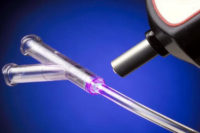Adjustability is a key factor when choosing assembly line seating, especially in today’s flexible, lean work environment. Engineers should look for chairs that feature adjustable heights and back tilts. How the chair and the operator fit together is crucial.
Adjustability is a key factor when choosing assembly line seating, especially in today’s flexible, lean work environment. Engineers should look for chairs that feature adjustable heights and back tilts.
“Each worker needs to be able to make the chair work for him or her,” says Liz Sworden, marketing manager at BioFit Engineered Products. “It doesn't matter how many adjustments a chair has if the operator doesn’t use them. Assemblers should be trained to adjust and use their chairs correctly.”
“I’m a big fan of adjustability at every point possible, and heartily recommend those features to clients,” adds David Verrill, applications support manager at IAC Industries Inc. “[However], maximum adjustability does not always equal a massive expense.
How the chair and the operator fit together is crucial. Whenever possible, an evaluation chair should be tried before making a decision.
“I have one of those mega-buck [awesome designer] chairs in my office,” explains Verrill. “Despite it having every ergonomic feature ever conceived, my back and right shoulder were in constant pain while using the chair, because it wouldn’t go high enough to seat me comfortably at my 32-inch high desk.
“Bevco [IAC’s chair partner] sent me one of its Value-Line chairs for a customer demo,” recalls Verrill. “Once I got it back from the customer, I started using it at my desk; my Advil intake cut to almost zero.
“That seems counter-intuitive since it only offers height adjustment and minor backrest adjustment, but the chair was contoured perfectly for me,” says Verrill. “The bottom line is that spending big money [for a workstation chair] doesn’t solve everything.”
Get our new eMagazine delivered to your inbox every month.
Stay in the know on the latest assembly trends.
SUBSCRIBE TODAY!Copyright ©2024. All Rights Reserved BNP Media.
Design, CMS, Hosting & Web Development :: ePublishing


